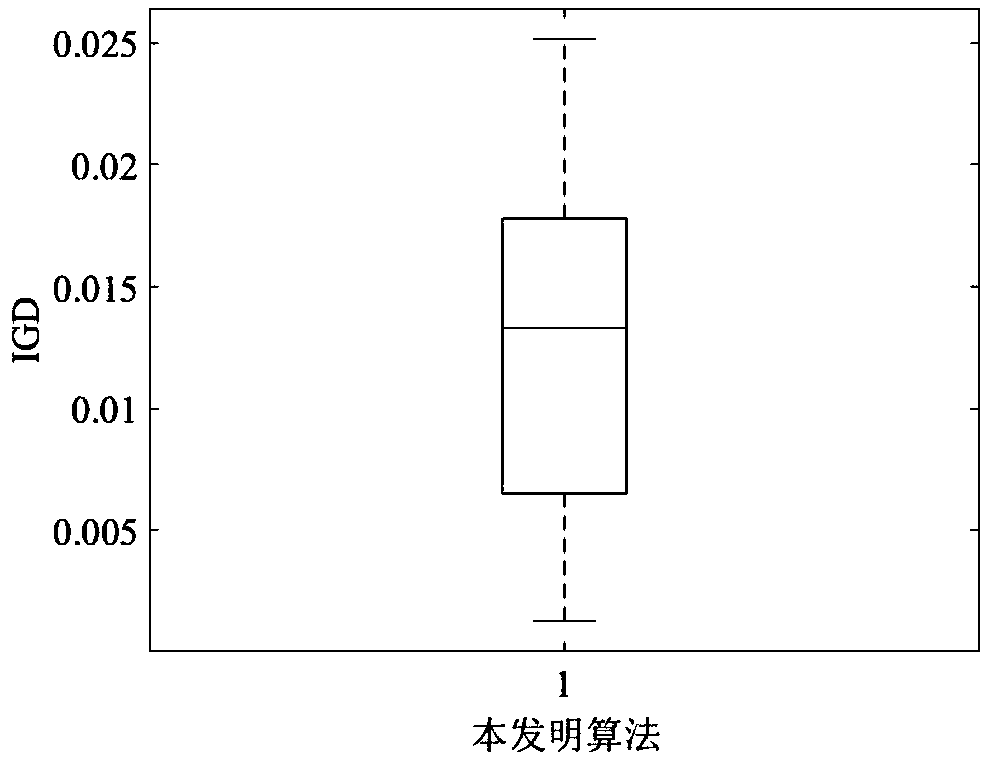A Massive Weapon-Target Allocation Method Based on Multi-objective Clonal Evolutionary Algorithm
An evolutionary algorithm and target allocation technology, applied in instruments, calculations, electrical digital data processing, etc., can solve problems such as single-objective optimization, inapplicable weapon-target allocation problems, etc., and achieve good convergence effect
- Summary
- Abstract
- Description
- Claims
- Application Information
AI Technical Summary
Problems solved by technology
Method used
Image
Examples
example 1
[0095] Example 1: The number of weapons is 8; the number of targets is 4; the number of weapon platforms is 3; the number of weapons on each platform Pnum=[3 3 2]; the target threat degree Th=[0.15 0.36 0.18 0.31]; the population size of the subpopulation is 20; the algorithm is the largest The number of iterations is 50; the damage probability D of the weapon platform to the target is:
[0096] D=[0.78 0.76 0.62 0.71;
[0097] 0.92 0.68 0.59 0.59;
[0098] 0.86 0.93 0.77 0.69]
[0099] In order to facilitate the comparison of the convergence of the algorithm, the exhaustive method is used to find the feasible solution and the pareto optimal solution in this example. The pareto optimal solution is shown in Table 1.
[0100] Table 1 pareto optimal solution
[0101] g
[0102] The algorithm proposed by the present invention is independently run 30 times, and the final dominant population is recorded each time. The IGD (Invertedgenerational distance) index is used to evaluate the perfor...
example 2
[0109] Example 2: The number of weapons is 50; the number of targets is 20; the number of weapon platforms is 10; the number of weapons on each platform Pnum=[5 5 55 5 5 5 5 5 5]; the target threat degree Th=[0.02 0.03 0.05 0.08 0.07 0.01 0.09 0.04 0.060 .05 0.05 0.05 0.03 0.07 0.02 0.08 0.04 0.06 0.01 0.09]; the population size of the subpopulation is 20; the maximum number of iterations of the algorithm is 50; the damage probability D of the weapon platform to the target is:
[0110] D=[0.783 0.762 0.627 0.712 0.651 0.794 0.944 0.852 0.969 0.752 0.7930.851 0.896 0.932 0.686 0.914 0.887 0.751 0.692 0.962;
[0111] 0.925 0.683 0.591 0.593 0.892 0.756 0.688 0.763 0.788 0.953 0.9680.863 0.648 0.794 0.814 0.925 0.694 0.832 0.674 0.845;
[0112] 0.866 0.934 0.772 0.695 0.598 0.897 0.754 0.685 0.763 0.755 0.7910.857 0.898 0.936 0.688 0.911 0.888 0.754 0.696 0.976;
[0113] 0.927 0.685 0.599 0.591 0.894 0.598 0.897 0.751 0.686 0.768 0.7920.854 0.893 0.938 0.684 0.927 0.696 0.835 0.673 0.847...
PUM
 Login to View More
Login to View More Abstract
Description
Claims
Application Information
 Login to View More
Login to View More - R&D
- Intellectual Property
- Life Sciences
- Materials
- Tech Scout
- Unparalleled Data Quality
- Higher Quality Content
- 60% Fewer Hallucinations
Browse by: Latest US Patents, China's latest patents, Technical Efficacy Thesaurus, Application Domain, Technology Topic, Popular Technical Reports.
© 2025 PatSnap. All rights reserved.Legal|Privacy policy|Modern Slavery Act Transparency Statement|Sitemap|About US| Contact US: help@patsnap.com



